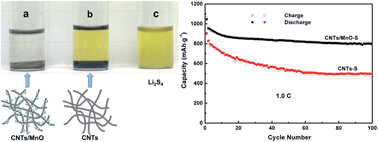MnO modified carbon nanotubes as a sulfur host with enhanced performance in Li/S batteries†
Abstract
Lithium/sulfur (Li/S) batteries have become promising future power sources owing to the high energy density. Carbon materials are the most used sulfur hosts, but their ability to adsorb polysulfide intermediates has been unreliable, thus recently many researchers have turned their interest to metal oxide materials. Here, we manufactured a composite of carbon nanotubes modified with manganese oxide nanoparticles (CNTs/MnO) as a sulfur host material. In Li/S cells, the CNTs/MnO–S cathode showed a rather better cycling stability over 100 cycles than a CNTs–S cathode with the same carbon/sulfur weight ratio of about 1 : 8. In addition, the CNTs/MnO–S cathode presented an initial discharge capacity of 716 mA h g−1 at a high current density of 5.0C, in contrast to the result of only 415 mA h g−1 with the CNTs–S cathode. Physical and electrochemical characterization proved that the MnO modification does not vary the surface area of the CNTs but lowers their electrical conductivity. By carefully comparing the differences in the 1st discharge capacities of the two cathodes, the MnO modification could obviously improve the initial utilization of S especially at high current densities. The improved electrochemical characteristics of the CNTs/MnO–S electrode can be attributed to its properties of a stronger adsorption capability for polysulfides.


 Please wait while we load your content...
Please wait while we load your content...